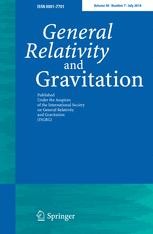GRG Editor's Choice: A primer of group theory for Loop Quantum Gravity and spin-foams
 Pierre Martin-Dussaud, A primer of group theory for Loop Quantum Gravity and spin-foams, Gen Relativ Gravit (2019) 51: 110. https://doi.org/10.1007/s10714-019-2583-5
Pierre Martin-Dussaud, A primer of group theory for Loop Quantum Gravity and spin-foams, Gen Relativ Gravit (2019) 51: 110. https://doi.org/10.1007/s10714-019-2583-5
Editor’s Choice (Invited Report: State of the field)
First Online: 3 September 2019
"When I first started working in loop quantum gravity and spin foams the challenge of learning the many methods without a single simple source was a time-consuming challenge. The present primer fills this hole in the literature. I am sure that this work will help not only beginning graduate students, but will also help researchers from outside of the loop quantum gravity community to more easily follow the work being done there, as well as being a very useful reference for experts. It is a great service to the community." (anonymous referee)
Abstract:
Calculations in Loop Quantum Gravity (LQG) and spin-foams theory rely heavily on group theory of SU(2) and SL2(C). Even though many monographs exist devoted to this theory, the different tools needed (e.g. representation theory, harmonic analysis, recoupling theory...) are often dispersed in different books, with different conventions and notations. This was the initial motivation for the compilation of the present document. Generally, these notes can serve three main purposes: a concise introduction for students to the essential mathematical tools of LQG, a convenient compendium for researchers, a translational hub between the conventions of the main references. These notes are aimed both at physicists, caring about their tools being mathematically well grounded, and at mathematicians, curious about how some of their familiar abstract structures can reveal the beauty of quantum gravity.
The authors:
Pierre Martin-Dussaud is working on his PhD under the supervision of Carlo Rovelli and Simone Speziale at Aix-Marseille Université, Marseilles.
GRG Editor's Choice:
In each volume of GRG, a few papers are marked as “Editor’s Choice”. The primary criteria is original, high quality research that is of wide interest within the community.
